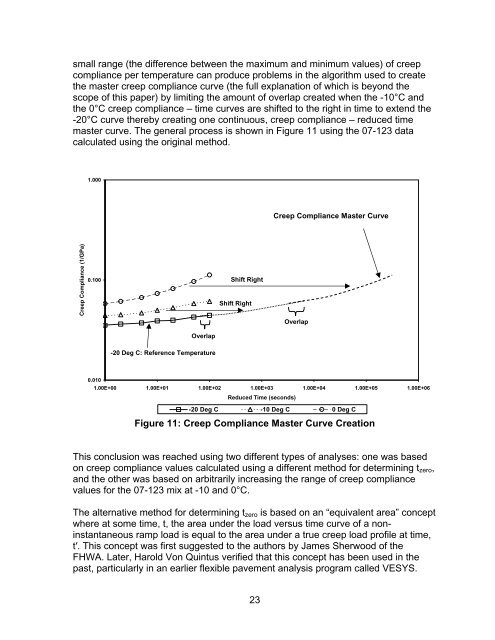Determination of Creep Compliance and Tensile Strength of Hot-Mix ...
Determination of Creep Compliance and Tensile Strength of Hot-Mix ...
Determination of Creep Compliance and Tensile Strength of Hot-Mix ...
- No tags were found...
You also want an ePaper? Increase the reach of your titles
YUMPU automatically turns print PDFs into web optimized ePapers that Google loves.
small range (the difference between the maximum <strong>and</strong> minimum values) <strong>of</strong> creepcompliance per temperature can produce problems in the algorithm used to createthe master creep compliance curve (the full explanation <strong>of</strong> which is beyond thescope <strong>of</strong> this paper) by limiting the amount <strong>of</strong> overlap created when the -10°C <strong>and</strong>the 0°C creep compliance – time curves are shifted to the right in time to extend the-20°C curve thereby creating one continuous, creep compliance – reduced timemaster curve. The general process is shown in Figure 11 using the 07-123 datacalculated using the original method.1.000<strong>Creep</strong> <strong>Compliance</strong> Master Curve<strong>Creep</strong> <strong>Compliance</strong> (1/GPa)0.100Shift RightShift RightOverlapOverlap-20 Deg C: Reference Temperature0.0101.00E+00 1.00E+01 1.00E+02 1.00E+03 1.00E+04 1.00E+05 1.00E+06Reduced Time (seconds)-20 Deg C -10 Deg C 0 Deg CFigure 11: <strong>Creep</strong> <strong>Compliance</strong> Master Curve CreationThis conclusion was reached using two different types <strong>of</strong> analyses: one was basedon creep compliance values calculated using a different method for determining t zero ,<strong>and</strong> the other was based on arbitrarily increasing the range <strong>of</strong> creep compliancevalues for the 07-123 mix at -10 <strong>and</strong> 0°C.The alternative method for determining t zero is based on an “equivalent area” conceptwhere at some time, t, the area under the load versus time curve <strong>of</strong> a noninstantaneousramp load is equal to the area under a true creep load pr<strong>of</strong>ile at time,t′. This concept was first suggested to the authors by James Sherwood <strong>of</strong> theFHWA. Later, Harold Von Quintus verified that this concept has been used in thepast, particularly in an earlier flexible pavement analysis program called VESYS.23
















